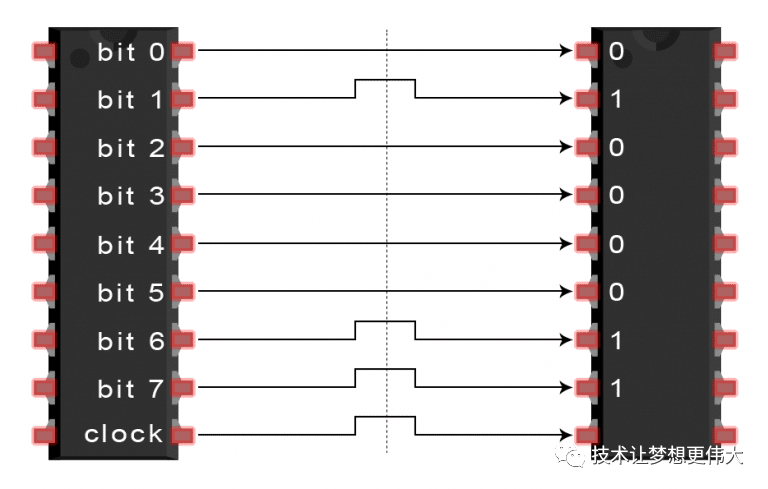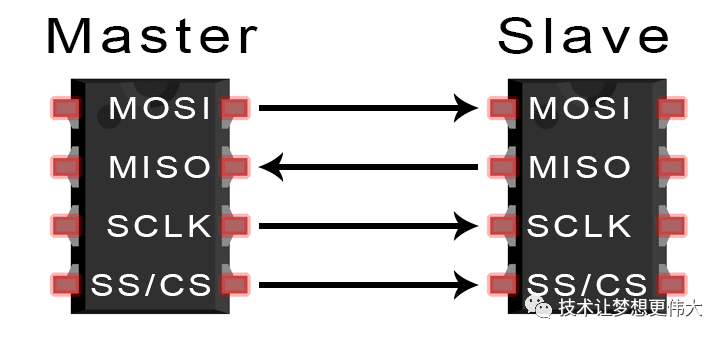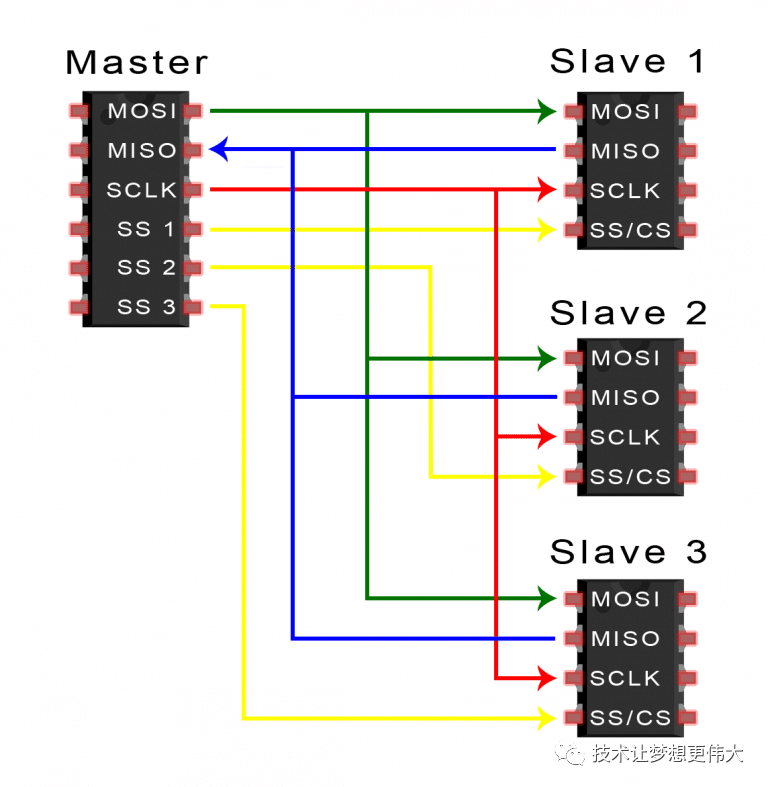basic of the spi communication protocol
关注、星标公众号,直达精彩内容
文章来源:https://www.circuitbasics.com/basics-of-the-spi-communication-protocol/
整理:技术让梦想更伟大 | 李肖遥
最近在SPI、QSPI上花了一些功夫,也看了下文章,这是armfly推荐的几篇写得好的文章之一,市面上有很多翻译的文章,但还是看着原版的较好,所以整理给大家看看,希望有帮助!
When you connect a microcontroller to a sensor, display, or other module, do you ever think about how the two devices talk to each other? What exactly are they saying? How are they able to understand each other?
Communication between electronic devices is like communication between humans. Both sides need to speak the same language. In electronics, these languages are called communication protocols. Luckily for us, there are only a few communication protocols we need to know when building most DIY electronics projects. In this series of articles, we will discuss the basics of the three most common protocols: Serial Peripheral Interface (SPI), Inter-Integrated Circuit (I2C), and Universal Asynchronous Receiver/Transmitter (UART) driven communication.
First, we’ll begin with some basic concepts about electronic communication, then explain in detail how SPI works. In the next article, we’ll discuss UART driven communication, and in the third article, we’ll dive into I2C.
SPI, I2C, and UART are quite a bit slower than protocols like USB, ethernet, Bluetooth, and WiFi, but they’re a lot more simple and use less hardware and system resources. SPI, I2C, and UART are ideal for communication between microcontrollers and between microcontrollers and sensors where large amounts of high speed data don’t need to be transferred.
SERIAL VS. PARALLEL COMMUNICATION
Electronic devices talk to each other by sending bits of data through wires physically connected between devices. A bit is like a letter in a word, except instead of the 26 letters (in the English alphabet), a bit is binary and can only be a 1 or 0. Bits are transferred from one device to another by quick changes in voltage. In a system operating at 5 V, a 0 bit is communicated as a short pulse of 0 V, and a 1 bit is communicated by a short pulse of 5 V.
The bits of data can be transmitted either in parallel or serial form. In parallel communication, the bits of data are sent all at the same time, each through a separate wire. The following diagram shows the parallel transmission of the letter “C” in binary (01000011):

Introduction to SPI - Parallel Transmission of One Byte
In serial communication, the bits are sent one by one through a single wire. The following diagram shows the serial transmission of the letter “C” in binary (01000011):
 Introduction to SPI - Serial Transmission of one byte
Introduction to SPI - Serial Transmission of one byte
INTRODUCTION TO SPI COMMUNICATION
SPI is a common communication protocol used by many different devices. For example, SD card reader modules, RFID card reader modules, and 2.4 GHz wireless transmitter/receivers all use SPI to communicate with microcontrollers.
One unique benefit of SPI is the fact that data can be transferred without interruption. Any number of bits can be sent or received in a continuous stream. With I2C and UART, data is sent in packets, limited to a specific number of bits. Start and stop conditions define the beginning and end of each packet, so the data is interrupted during transmission.
Devices communicating via SPI are in a master-slave relationship. The master is the controlling device (usually a microcontroller), while the slave (usually a sensor, display, or memory chip) takes instruction from the master. The simplest configuration of SPI is a single master, single slave system, but one master can control more than one slave (more on this below).
 Introduction to SPI - Master and Slave
Introduction to SPI - Master and Slave
MOSI (Master Output/Slave Input) – Line for the master to send data to the slave.
MISO (Master Input/Slave Output) – Line for the slave to send data to the master.
SCLK (Clock) – Line for the clock signal.
SS/CS (Slave Select/Chip Select) – Line for the master to select which slave to send data to.

Basics of the SPI Communication Protocol - Specifications Table
*In practice, the number of slaves is limited by the load capacitance of the system, which reduces the ability of the master to accurately switch between voltage levels.
HOW SPI WORKS
THE CLOCK
The clock signal synchronizes the output of data bits from the master to the sampling of bits by the slave. One bit of data is transferred in each clock cycle, so the speed of data transfer is determined by the frequency of the clock signal. SPI communication is always initiated by the master since the master configures and generates the clock signal.
Any communication protocol where devices share a clock signal is known as synchronous. SPI is a synchronous communication protocol. There are also asynchronous methods that don’t use a clock signal. For example, in UART communication, both sides are set to a pre-configured baud rate that dictates the speed and timing of data transmission.
The clock signal in SPI can be modified using the properties of clock polarity and clock phase. These two properties work together to define when the bits are output and when they are sampled. Clock polarity can be set by the master to allow for bits to be output and sampled on either the rising or falling edge of the clock cycle. Clock phase can be set for output and sampling to occur on either the first edge or second edge of the clock cycle, regardless of whether it is rising or falling.
SLAVE SELECT
The master can choose which slave it wants to talk to by setting the slave’s CS/SS line to a low voltage level. In the idle, non-transmitting state, the slave select line is kept at a high voltage level. Multiple CS/SS pins may be available on the master, which allows for multiple slaves to be wired in parallel. If only one CS/SS pin is present, multiple slaves can be wired to the master by daisy-chaining.
MULTIPLE SLAVES
SPI can be set up to operate with a single master and a single slave, and it can be set up with multiple slaves controlled by a single master. There are two ways to connect multiple slaves to the master. If the master has multiple slave select pins, the slaves can be wired in parallel like this:

Introduction to SPI - Multiple Slave Configuration Separate Slave Select
If only one slave select pin is available, the slaves can be daisy-chained like this:
Introduction to SPI - Multiple Slave Configuration Daisy Chained

MOSI AND MISO
The master sends data to the slave bit by bit, in serial through the MOSI line. The slave receives the data sent from the master at the MOSI pin. Data sent from the master to the slave is usually sent with the most significant bit first.
The slave can also send data back to the master through the MISO line in serial. The data sent from the slave back to the master is usually sent with the least significant bit first.
STEPS OF SPI DATA TRANSMISSION
The master outputs the clock signal:
 Introduction to SPI - Data Transmission Diagram Clock Signal
Introduction to SPI - Data Transmission Diagram Clock Signal
The master switches the SS/CS pin to a low voltage state, which activates the slave:
 Introduction to SPI - Data Transmission Diagram Slave Select Activation
Introduction to SPI - Data Transmission Diagram Slave Select Activation
The master sends the data one bit at a time to the slave along the MOSI line. The slave reads the bits as they are received:
 Introduction to SPI - Data Transmission Diagram Master to Slave Data Transfer
Introduction to SPI - Data Transmission Diagram Master to Slave Data Transfer
If a response is needed, the slave returns data one bit at a time to the master along the MISO line. The master reads the bits as they are received:
 Introduction to SPI - Data Transmission Diagram Slave to Master Data Transfer
Introduction to SPI - Data Transmission Diagram Slave to Master Data Transfer
ADVANTAGES AND DISADVANTAGES OF SPI
There are some advantages and disadvantages to using SPI, and if given the choice between different communication protocols, you should know when to use SPI according to the requirements of your project:
ADVANTAGES
No start and stop bits, so the data can be streamed continuously without interruption No complicated slave addressing system like I2C Higher data transfer rate than I2C (almost twice as fast) Separate MISO and MOSI lines, so data can be sent and received at the same time
DISADVANTAGES
Uses four wires (I2C and UARTs use two) No acknowledgement that the data has been successfully received (I2C has this) No form of error checking like the parity bit in UART Only allows for a single master Hopefully this article has given you a better understanding of SPI. Continue on to part two of this series to learn about UART driven communication, or to part three where we discuss the I2C protocol.
‧‧‧‧‧‧‧‧‧‧‧‧‧‧‧‧ END ‧‧‧‧‧‧‧‧‧‧‧‧‧‧‧‧
关注我的微信公众号,回复“加群”按规则加入技术交流群。
点击“阅读原文”查看更多分享,欢迎点分享、收藏、点赞、在看。
